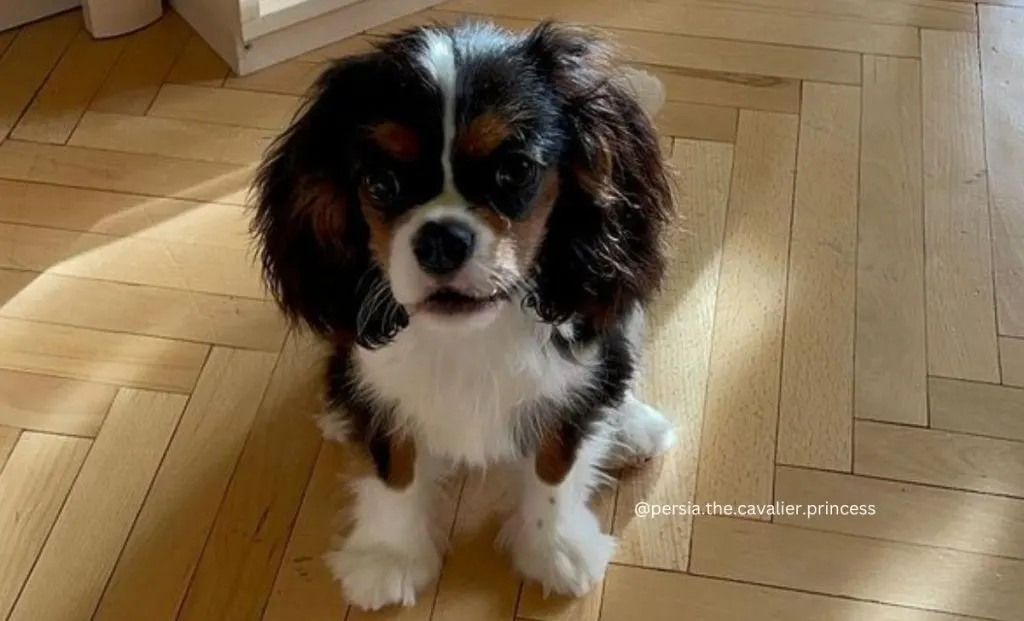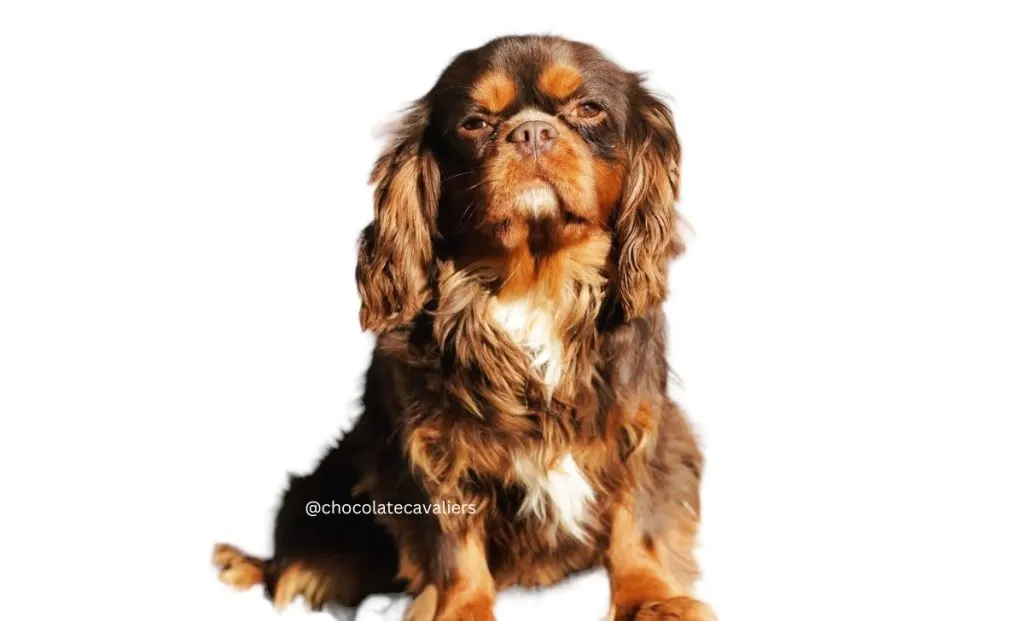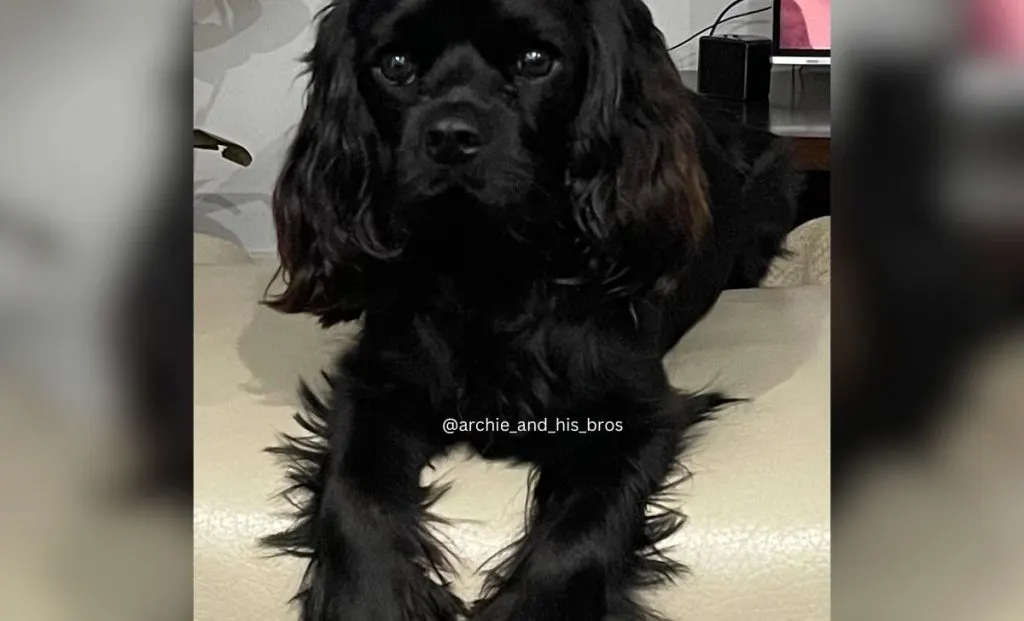The Cavalier King Charles Spaniel is a spectacular toy category pup that is celebrated for its easygoing and loving temperament.
They originate from the United Kingdom, and with a name like this, you know that they are exceptional canines!
If you’ve been contemplating getting a Cavalier, you must have wondered what Cavalier King Charles Spaniel colors are there! Well, I have all the information about the fancy colors that occur in this royal breed.
Cavaliers are intelligent and sweet pups with a silky coat.
They can do well with a senior owner since they aren’t demanding canines and need smaller amounts of exercise.
They are flexible, loyal, and can do well in flats and houses with a lawn.
Cavaliers make incredible puppies for families. They are gentle and playful with kids and are a pretty tolerant dog breed.
Remember that there must constantly be management while your younger kids interact with your pup, regardless of how trusted the canine is.
Youngsters must be taught to respect canines and how to approach them.
During this Cavalier King Charles Spaniel color overview, we will discuss both the colors and color traits accepted by the American Kennel Club (AKC) and those that are not.
American Kennel Club Approved Colors
When a dog color is accepted by the American Kennel Club (AKC), it means that the AKC recognizes that particular color as standard for that breed.
This recognition typically comes after careful consideration and evaluation by the AKC breed standard committee, which assesses whether the color meets the breed’s historical and traditional norms.
Accepted colors are often those that are commonly seen in the breed’s population and are considered desirable by breed enthusiasts.
Dogs of accepted colors can compete in AKC conformation events and be registered with the AKC, provided they meet all other breed standards.
1. Blenheim

The most ordinary Cavalier King Charles Spaniel color is the one we call Blenheim.
The name of the color comes from Blenheim Palace, where this dog breed was raised by the Duke of Marlborough (John Churchill) in the 18th century.
The shade is white with chestnut (light brown) markings that occur all over the dog’s body and around their eyes. The exact shade depends on the exact breeding of the pup.
Most pups of this color have a white muzzle with a chestnut blaze on their forehead.
A chestnut-colored area on the top of a Blenheim head is often called a “Blenheim Kiss” (or even the lozenge spot), much like the color name; there is a mythology behind the nickname.
The legend states that while the Duke of Marlborough was away at war, his missis took solace in the company of their Spaniels. One of the canines was expecting pups, and she pressed her thumb against the forehead of this canine.
When the combat was won, the Duke was welcomed with five pups, all bearing distinctive markings. The marking was anointed the “Duchess Thumbprint” and, later on, the “Blenheim Kiss.”
Due to the breeding history of these dogs, the Blenheim parti-color type is the most ordinary coat found on a Cavalier.
- You will exclusively acquire Blenheim pups when a Blenheim is bred to a Blenheim. The Blenheim color has the most straightforward genetic makeup.
- A Blenheim dog bred to a Tri-Colour dog can produce either Blenheim or Tri-Colour pups.
- However, a Blenheim, bred to Black and Tan dog, can create all four shades with some white markings on the solid color pups. White mismarkings are generally found on the dog’s chest, the center of the face, and paws, but they may diminish with age.
- When a Blenheim is bred to a Ruby dog, either Blenheim or Ruby-colored pups are possible, with some white color markings (mismarkings) on the Ruby-colored puppies.
2. Black and Tan

Black and tan Cavalier dogs are the rarest and most well-known type.
This color combination is represented by black body fur with tan highlights around the nails of the dog, their cheeks, and their eyebrows. Periodically, tan markings occur inside the ears or on the legs.
Occasionally, they have white markings on them when bred to a parti-color Cavs or, as we call them, parti Cavaliers.
Black and tan Cavalier pups with white areas or markings are considered high-standard pups in dog shows, as the black and tan Cavalier King Charles Spaniel color variation was celebrated in English court.
The Black and Tan full-colored King Charles Cavalier dogs are said to be the rarest coat color acknowledged by the American Kennel Club (AKC).
- When bred to a Blenheim or tri-color dog, they are able to produce all four shades with the chance of white mismarkings on the Ruby and Black and Tan pups.
- A Black and Tan dog bred to another Black and Tan dog will produce all Black and Tan pups.
- A Black and Tan dog bred to a Ruby dog will produce either Black and Tan or Ruby offspring.
- Mismarkings do decrease with adulthood. How much white color will remain in adulthood depends on the fact of how much was there at birth. Tiny amounts of white fur on the chest will most likely disappear as the dog ages, while a significant amount will stay. White on the feet tends to stay.
3. Ruby

Just two solid colors, or whole colors as they are also called, occur among these little dogs, and solid ruby is one of them.
While the name of the color implies a deep red, the coat of ruby Cavalier King Charles Spaniel dogs is more reddish or rich chestnut colored.
It is a reasonably rare shade because many Cavaliers have some markings present.
Markings are evaluated as confirmation shortcomings by the American Kennel Club.
- A Ruby dog bred to a Ruby dog will always produce all Ruby pups.
- When a Ruby dog breeds a Black and Tan dog, it will make either Ruby or Black and Tan pups.
- Ruby bred to a tri-color can result in all four shades with the probability of white mismarkings on the Ruby and Black and Tan pups.
- A Ruby bred to a Blenehim can deliver either Ruby or Blenheim-colored pups, and some white mismarkings on the Ruby-colored pups are likely.
- Breeding a Ruby-colored dog to a Blenheim-colored dog can also enormously improve the richness of the Blenheim pup’s coloring.
4. Black and White

This is the rarest coloring that is seen in this breed, within standard.
Since the black and white Spaniel dogs are scarce, the price that you will pay for one of these puppies is much higher than it would be for other colors.
These King Charles Spaniels have fully jet black bodies but we can notice white fur on the face of the dog, the chest, and the feet.
Breeders of King Charles Spaniels and dog enthusiasts within this breed are constantly looking for this coloring to add to their breeding program or life.
Most black and white Cavalier dogs have tan markings, which are ordinary in most shade variations.
American Kennel Club Non Recognized Colors
In this part, we are going to learn more about the colors that are not accepted in the breed standard by the AKC, but they happen nevertheless.
When a color is not accepted by the American Kennel Club, it means that the AKC does not recognize that color as standard for that particular breed.
This could be due to various reasons, including rarity, deviation from the breed standard, or lack of historical precedence.
Dogs of non-accepted colors may still be purebred representatives of the breed but may face limitations in AKC competitions and registration.
Breeders and owners of dogs with non-standard colors may choose to participate in alternative dog sports or events outside of the AKC’s jurisdiction or focus on breeding for other desirable traits within the breed standard.
5. Tricolor

Tricolor furs have a white or jet-black base with white, black, and tan markings.
Markings occur around the eyes and ears, frequently divided by a blaze up the middle of the muzzle.
In the English court, the tricolor type of King Charles Cavalier was downgraded to a “Prince Charles” Cavalier, as it was not the best dog color.
- You can obtain tri-color and Blenheim pups when you breed tri-color to a Blenheim.
- Breeding a tri-color dog to another tri-color, you will most probably get all tri-color pups unless both dog parents are created from a Blenheim bred with a Tri or Blenheim X Black and Tan parents; in this case, you can receive both Blenheim or tri-color pups.
- A Tri Colour dog bred to either Ruby colored dog or a Black and Tan can produce all four shades with the possibility of mismarkings on the solid-colored pups.
6. Chocolate

The chocolate Cavalier King Charles Spaniel type is a tricolored dog that combines white, ruby, and jet black.
Standardbred colors include chocolate and chocolate, with white as the official color.
But some tricolor Cavalier dogs have a chocolate blenheim color combination.
7. White

White Spaniels are the rarest, as this color only comes from a genetic defect.
White pups are born with a lack of pigment in their fur rather than having a gene that codes for that color.
When discussing the Cavalier King Charles Spaniel breed, all white dogs are albinos. This phenomenon can be found in all dog breeds or animal species, including us humans.
Albinos will also have pale skin, white fur, and pale eyes since they have no pigment.
Albino dogs will typically not be bred thanks to the risk of passing on the health condition. Yet, it is a gene mutation that can happen in any litter.
Sores, bumps, and bruises that don’t heal correctly should be carefully inspected by a vet for malignant disease.
These pups are also born with eye abnormalities that can impact their vision, so they need extra care.
8. Merle

Merle-colored Cavalier pups are not purebred because the specific classic merle gene that codes for the color is not part of the Cavalier breed standard.
Merle furs are caused by a dominant gene divergence that gives merle dogs blue eyes and different rare coat colors.
Merle areas can be patterned and cover the dog’s whole body or just a part of it, while the ears are usually solid colored.
This color expression requires the puppy to have what’s called the M allele of the PMEL gene.
However, this gene is the dominant one, meaning it will constantly be represented in the form of a merle-colored coat if it is there, making it easy to differentiate which puppies carry the gene.
If it was just the coat hue that the M allele coded for, it probably wouldn’t be a reason for worry. Yet, pups that carry the gene are in danger of developing other problems associated with the allele.
9. Tan

Tan Cavaliers have red-colored fur, but it is lighter than that of ruby-colored pups.
Unlike ruby, a standard color, tan pups are deemed out of standard. The color is striking, but it’s not overly ordinary.
10. Black

There is no evidence to support the claim that black-colored Cavaliers are unhealthy but that does seem to be the general opinion with the breed enthusiasts.
Some people may believe that black-colored Cavaliers are unhealthy because they are more likely to suffer from certain genetic conditions, such as eye problems.
However, this is not true. All Cavaliers, regardless of coat color, are susceptible to these conditions.
If you are concerned about the health of your Cavalier, it is always best to consult with your veterinarian.
11. White Markings

The white patches or markings occur from the white piebald gene and can happen in any other Cavalier color.
White markings are deemed out of standard and will prevent a pup from competing in American Kennel Club-sanctioned shows.
Missmarks
The major Kennel Clubs have listed several mismarkings or “incorrect” color fur patterns for the Cavalier King Charles Spaniel dogs, like:
- The incorrect white – Too much white on the face of the pup or its body. Usually seen in Blenheim-colored pups or the tri-color ones. Any white on a Ruby or a Black and Tan colored pup
- Ticking – Excessive ticking (small spots) on a Blenheim or Tri-Colour puppy
- The Incorrect Tan – Usually happens on Tri Coloured dogs and the Black and Tan ones
- The Incomplete Pigment – This happens in Blenheim or tri-color dogs, usually on their eye rims and nose
- Blue Eyes – This is usually only seen on a Blenheim or tricolor Cavalier
Now, here are some critical Kennel Club facts about the color allowances for this breed:
When breeding Cavaliers, “incorrect” color patterns are more or less to be expected, and there is virtually no way to avoid it!
Here Is Why …
The white Piebald gene, which creates the color pattern for the Blenheim and Tri-Colour dogs, is recessive to the solid gene on the Spotting Locus.
Yet, the Cavaliers are homozygous dogs in most cases, meaning that most of them carry the white Piebald gene and will produce pups with different amounts of white.
Mismarkings generally take form as patches of color on the toes, chest, face, and sometimes on the underside of the tail spot in a Black and Tan Cavalier dog.
When looking into the Blenheim dog and the Tricolor Cavalier, there is too much white or ticking on the face or body, or even incorrect tan markings on Tri-Color or a Black and Tan.
Or too much white or ticking on the face or body of a Blenheim dog and tri-color one, or incorrect tan markings on a Black and Tan or tri-color.
To this day, no one can specify what regulates the “too much white” gene, and thus, it’s all but impossible to eradicate it from showing up as a mismarking.
Eye Color
Cavalier King Charles Spaniel dogs are supposed to have dark-colored eyes. They are usually brown, with varying shades.
Pups with too many head-white markings are in danger of having strange b
There have only been a few single blue eyed Cavalier Kings Charlie Spaniels in the history of the breed and even fewer double blue eyed Cavaliers.
Nose Color
Cavaliers create a black pigment called eumelanin and must have a black-colored nose.
However, recessive red is known to occasionally induce fading of the nose pigment.
And some pups with extended white spotting on their muzzle might be born with a pink-spotted nose.
Coat Color Correlation With Health Issues
The only two shades that are related to health disorders are merle and white.
White Cavalier dogs are actually albinos, so they are a significant risk for specific health issues like light sensitivity and skin cancer.
This is the case for any individual affected with albinism, no matter the species. Albinism is caused by the lack of pigment in the skin.
Merle-colored puppies are outcomes of cross-breeding. While this color is expected in dog breeds like Border Collies and Australian Shepherds, it happens much less often (never) in Cavalier King Charles Spaniel dogs.
The possible issues include growing big white patches on their skin, a decrease in retinal pigment that can result in blindness, and decreasing numbers of cells in the internal ear, which can lead to deafness.
It must be mentioned that with proper healthcare, merle pups can live long, happy lives that last their entire lifespan.
Yet they are inclined to disorders that other colors of Cavalier dogs are not, and merles are not recommended for breeding.
To Sum It All Up
From gorgeous show stoppers at dog shows to precious companions, no matter what color pattern the Cavalier King Charles Spaniel comes in, they will find their way into your heart.
However, did you know that Charles Spaniel is among 19 breeds with the shortest lifespan?
But it is worth it, because Cavaliers are like little rays of sunshine wrapped in fur!
Their affectionate nature melts away all your worries, and those big, soulful eyes? Total heart stealers!
They love being with their families and are particularly inclined to suffer from separation anxiety if they are left unattended for lengthy periods.
So, it would be best if you only considered the Cavalier if you’re home a lot.
Once you have a Cavalier in your life, you’ll wonder how you ever lived without one.
Trust me, bringing home a Cavalier King Charles puppy is like adding a sprinkle of magic to your everyday life!

Nandina has been a lifelong dog owner and enthusiast. She shared her home with multiple breeds, including Giant Schnauzers, Cane Corsos, and Huskies. Currently, she is raising a three-year-old rescue and a working-line German Shepherd puppy.
Actively engaged in IGP dog sports for two years, Nandina is a certified instructor for basic obedience and socialization. She works as a trainer in her local dog sports club, and in her spare time, she handicrafts biothane gear for dogs.
